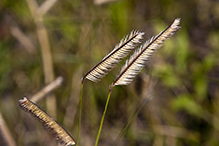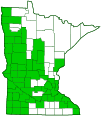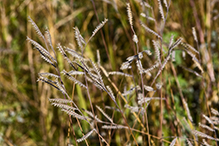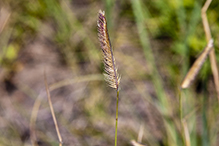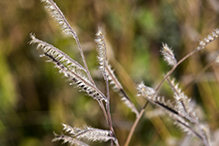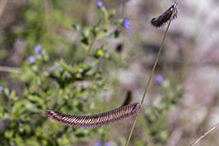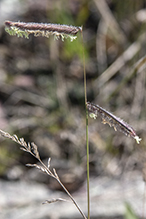blue grama
(Bouteloua gracilis)
Conservation • Description • Habitat • Ecology • Use • Distribution • Taxonomy
Conservation Status |
|
|||||||
| IUCN Red List | not listed |
|||||||
| NatureServe | N3N5 - Vulnerable to Secure SNR - Unranked |
|||||||
| Minnesota | not listed |
|||||||
Description |
||
Blue grama is a relatively short, erect or ascending, long-lived, perennial grass that rises from fibrous roots and often a short, stout rhizome. It forms dense tufts or, under heavy grazing, sod. It is an important forage species and is prominent on the short-grass prairies of the Great Plains. The culms are erect or ascending. They can be 6″ to 24″ tall but are usually no more than 12″ in height. They are unbranched, have usually 2 or 3 nodes, and are not woody at the base. They are hairless between the lower nodes. The leaves are mostly basal, ¾″ to 6″ long, 1 ⁄32″ to 1 ⁄16″ wide, and usually somewhat curled. They are flat or have margins that are rolled inward toward the upper side, especially toward the tip. The upper surface has short, soft hairs, especially near the base, or is rough to the touch with short, stiff hairs. The lower surface is smooth or lightly rough to the touch. The margins have short hairs near the base. The leaf sheaths are open, rounded on the back, and mostly hairless. The lowermost sheath is sometimes sparsely covered on the inside with soft, straight hairs. The ligule is a dense fringe of short hairs. The collar is distinctly yellowish-green. There are no ear-like appendages (auricles) at the base of the blade. The inflorescence is 1 to 6, usually no more than 4, loosely spaced spikes at the end of the stem. The spikes are 9 ⁄16″ to 1 9 ⁄16″ long and are straight at first, curling upward at maturity to resemble human eyelashes. Each spike has 20 to 60 densely packed spikelets arranged in 2 rows along one side of the central axis (rachis). The rachis does not extend past the uppermost spikelet. The spikelets are about 3 ⁄16″ long. The anthers are yellow. The upper glume is sparsely hairy along the midvein. The fruit is grain about ⅛″ long. |
||
Height |
||
6″ to 12″ |
||
Similar Species |
||
Hairy grama (Bouteloua hirsuta var. hirsuta) spike rachis extends ⅛″ to ⅜″ beyond the uppermost spikelet forming a stiff bristle. The upper glume is densely hairy along the midvein. |
||
Habitat |
||
Dry. Prairies. |
||
Ecology |
||
Flowering |
||
July to September |
||
Pests and Diseases |
||
|
||
Use |
||
|
||
Distribution |
||||
|
Sources |
|||
| 2/22/2023 | ||||
Nativity |
||||
Native |
||||
Occurrence |
||||
Common |
||||
Taxonomy |
|||
| Kingdom | Plantae (Plants) | ||
| Division | Tracheophyta (Vascular Plants) | ||
| Subdivision | Spermatophytina (Seed Plants) | ||
| Class | Liliopsida (Monocots) | ||
Order |
Poales (grasses, sedges, cattails, and allies) | ||
Family |
Poaceae (grasses) | ||
| No Rank | PACMAD clade | ||
| Subfamily | Chloridoideae | ||
| Tribe | Cynodonteae | ||
| Subtribe | Boutelouinae | ||
Genus |
Bouteloua (gramas) | ||
Synonyms |
|||
Actinochloa gracilis Atheropogon gracilis Atheropogon oligostachyus Bouteloua gracilis Bouteloua gracilis var. gracilis Bouteloua gracilis var. major Bouteloua gracilis f. pallida Bouteloua gracilis var. stricta Bouteloua major Bouteloua oligostachya Bouteloua oligostachya var. major Bouteloua oligostachya var. pallida Bouteloua stricta Chondrosium gracile Chondrosum gracile Chondrosum gracile var. polystachyum Chondrosum oligostachyum Eutriana gracilis Eutriana oligostachya |
|||
Common Names |
|||
blue grama blue grama grass eyelash grass graceful grama grass |
|||
Glossary
Auricle
A small, ear-like projection at the base of a leaf or at the junction of a grass blade and stem.
Collar
The area on the back of a grass leaf at the junction of the sheath and the blade.
Culm
The hollow or pithy stem of a grass, sedge, or rush.
Glume
A chaffy, empty, sterile bract at the base of a grass spikelet. Glumes usually occur in pairs, but occasionally only one is present.
Ligule
In grasses, a membranous appendage at the junction of the leaf and the leaf sheath, sometimes no more than a fringe of hairs.
Node
The small swelling of the stem from which one or more leaves, branches, or buds originate.
Rachis
The main axis of a compound leaf, appearing as an extension of the leaf stalk; the main axis of an inflorescence.
Sheath
The lower part of the leaf that surrounds the stem.

Slideshows |
||

Visitor Videos |
|||
Share your video of this plant. |
|||
| This button not working for you? Simply email us at info@MinnesotaSeasons.com. Attach a video, a YouTube link, or a cloud storage link. |
|||
Other Videos |
|||

Visitor Sightings |
|||||
Report a sighting of this plant. |
|||||
| This button not working for you? Simply email us at info@MinnesotaSeasons.com. Be sure to include a location. |
|||||
|
|||||
MinnesotaSeasons.com Sightings |
|||||

|
Created: Last Updated: © MinnesotaSeasons.com. All rights reserved. |
